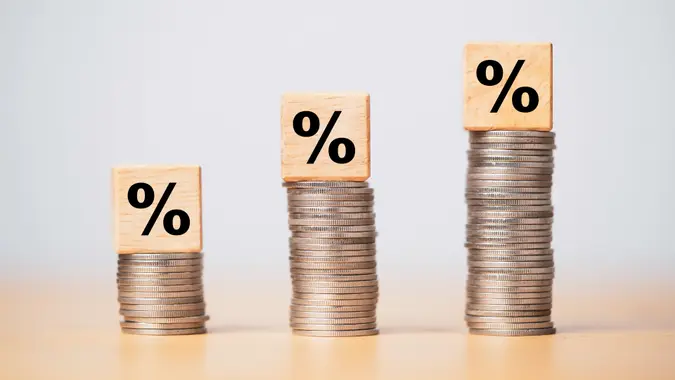How Much You Should Have in Your Savings Account in Your 50s, According to Experts

Commitment to Our Readers
GOBankingRates' editorial team is committed to bringing you unbiased reviews and information. We use data-driven methodologies to evaluate financial products and services - our reviews and ratings are not influenced by advertisers. You can read more about our editorial guidelines and our products and services review methodology.

20 Years
Helping You Live Richer

Reviewed
by Experts

Trusted by
Millions of Readers
In terms of personal finance, the big 5-0 is an important year that puts you in the on-deck circle for retirement. That birthday, after all, is when the IRS allows you to start making catch-up contributions to your tax-advantaged accounts. So, just how much savings should you have in your 50s?
Much has been written for decades about retirement savings targets. Financial experts like T. Rowe Price, for example, recommend having three to six times your annual salary socked away for retirement by the time you turn 50. Others recommend at least six times as well as being free of debt (or close to it), while simultaneously taking advantage of retirement plans and high-yield savings accounts.
With that in mind, people might be tempted to invest as much as humanly possible, even at the expense of their savings. But for many people, 50 can be an expensive year thanks to growing children, aging parents and higher healthcare bills. The last thing in the world they need is an early withdrawal penalty on their 401(k) plans because they wrung too much out of their savings or other bank accounts.
If you’re entering your sixth decade, here’s what you need to know about finding your savings sweet spot.
Staring Down the Barrel of Retirement
For many people in their 50s, a scary fact is that they don’t have much stored away in a retirement account, money market account, certificate of deposit (CD) or any other place that can earn compounding interest. With retirement just around the corner, many Americans in their 50s making $50,000 a year should have at least $250,000 to $300,000.
With the finish line in sight, that’s the worst-case scenario that must drive your calculations. So if two to three years’ worth isn’t realistic, how much should a 50-year-old allocate to savings?
“Depending on your risk tolerance and investment strategy, this should be 5%-20% of your portfolio,” said Gabriel Lalonde, CFP and president of MDL Financial Group.
The Evolution of the Middle-Age Emergency Fund
With more people focused on not over-extending their credit card let alone trying to start saving money, emergency funds tend to look more just like checking accounts. There is, of course, no one magic number to have saved by a certain age that will strike the proper balance for everyone.
“The right amount of cash to keep in savings accounts as middle-aged people turn 50 depends on individual circumstances and financial goals,” said Lalonde, “But as you approach 50, you should have a solid emergency fund.”
The term “solid,” however, changes at 50 — as does the concept of an emergency.
The Boilerplate Advice From Before Expires at 49
The IRS allows you to start padding your 401(k) or IRA at age 50 because that’s when most people begin the sprint to the retirement finish line. The clock starts ticking much faster as middle age winds down, and without sufficient savings, you won’t have time to recover if you encounter a major setback.
That reality validates the survey’s most prudent savers with five figures on hand for a rainy day.
Lalonde notes that the standard emergency fund “should cover three to six months’ worth of expenses and be kept in a liquid savings account that can be easily accessed in case of unexpected expenses or job loss.”
But at 50, that’s no longer enough. “You should also set aside some cash reserves to provide stability and security in case of market volatility,” Lalonde said.
So, How Much Is Enough?
The bottom line is that your savings versus worst-case scenarios can feel financially scary. According to Fulton Bank, 50-year-olds should adjust their savings accounts from the standard three to six months’ worth of expenses to two to three years’ worth — and for good reason.
While you might despise the thought of that much cash losing value to inflation as retirement nears when it could be earning you much-needed gains on the stock market, consider the alternative.
Imagine you lose your job or suffer some other major setback now, just as you’re supposed to be catching up. If you’re a 50-something with less than $2,000 in savings, you’ll have to start selling off your investment portfolio right when you need to grow it the most.
If that happens during a market downturn like the one that stymied investors in recent years, you’ll sell at a loss. If it forces you to pull from a tax-sheltered account like a 401(k), you’ll eat the loss and take an early withdrawal penalty, to boot.
Andrew Lisa contributed to the reporting for this article.
More From GOBankingRates
 Written by
Written by  Edited by
Edited by 

























